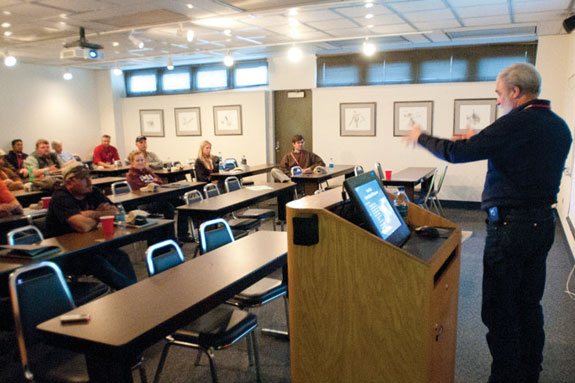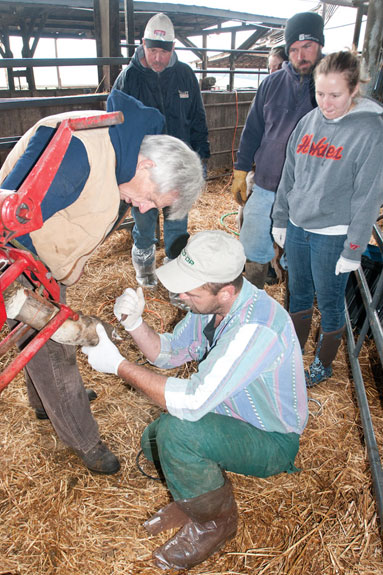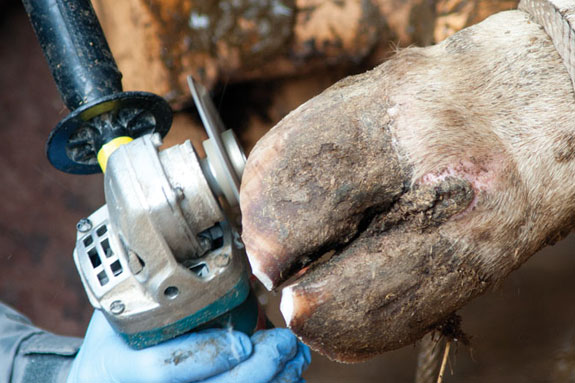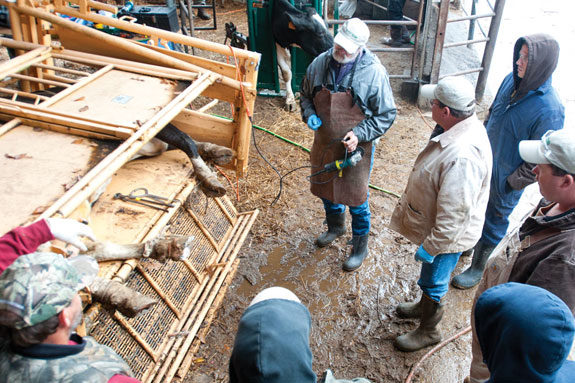Two of the most internationally respected experts on dairy cattle hoof health — Dr. Jan Shearer of Iowa State University and Dr. Sarel Van Amstel of the University of Tennessee — led 12 dairy producers and one professional hoof trimmer in a three-day educational session on proper hoof care during Tennessee Farmers Cooperative’s Hoof School Nov. 3-5.
The school, an initiative of TFC’s Dairy Directions program, featured both classroom lectures at UT’s Knoxville campus and hands-on hoof-trimming clinics held at Mac Pate’s dairy farm in Marvyille. The in-depth program gave the producers an opportunity to learn more about common hoof ailments and how to treat them and then try their hands at hoof-trimming with help from Shearer and Van Amstel.
“We hope that the Hoof School is a valuable educational experience that helps these producers improve the quality of the foot management practices they have in place for their cattle,” said Denny Sells, TFC feed and animal health specialist. “With confined cattle, hoof health is one of the biggest problems that most dairy producers face. A lot of these farmers don’t have access to trimmers or don’t have a broad base of knowledge on how to use them. We want this school to give them the knowledge they need to be effective hoof-health managers on the farm.”

On the first day of the school, attendees took part in classroom lectures on the significance of lameness, abnormalities of the hoof, biomechanics, anatomy, disease, laminitis, nutrition, and sharpening knives among other topics.
Samantha Craun, who helps run Davis Brothers Dairy in Philadelphia, said she benefited considerably from these lessons.
“Farmers have all these terms for things that go wrong with a cow, but now I’ve learned what the proper names are and not just say this cow is ‘lame’ or this cow has a ‘strawberry,’” Craun said. “I plan to put what I’ve learned to work on the farm and do a better job with record-keeping so we can know in more detail what the problem is.”
Shearer, who has conducted similar schools with Van Amstel across the U.S. as well as abroad, said the importance of maintaining proper hoof health in their herds cannot be emphasized enough to producers.
“According to economic analysis conducted by Cornell University, lameness is probably the single-most costly disease in dairy herds,” said Shearer. “Being able to recognize the problems early and understand what causes those particular conditions is really a key part of preventing them. Our objective here is to try to show the producers what these diseases are, how they develop, how to treat them, and how to correct them.”

On Days 2 and 3 of Hoof School, the 12 producers applied what they learned in the classroom by participating in live hoof-trimming. The group met at Pate’s Maryville dairy farm where Shearer and Van Amstel demonstrated proper techniques and explained how hoof care is imperative in getting optimal production from any dairy cow.
“Our hope is that by having them do a lot of trimming and footwork, with Dr. Van Amstel and me explaining things along the way, these dairy producers will understand lameness a lot better,” Shearer said. “They will know how to trim properly and how to fix hooves that have problems.”
Some of the farmers, like Crossville dairyman Dee Baisley, were already familiar with the hoof-trimming equipment being used. Through the Tennessee Agricultural Enhancement Program (TAEP), Baisley purchased a tilt table that he uses in working with his cows.
“This is a chance for me to brush up on what I’ve been doing and make sure I’m doing things right,” said Baisley, who milks 180 Holsteins. “I’ve seen some areas that I need to improve and others where I’m doing OK. If you keep your cows’ hooves maintained, then you don’t have excessive cost to repair, and the cow is more comfortable. And if the cow is more comfortable, she’s going to make more milk.”

Johnny Pitcock, who milks 150 head daily at his dairy in Fayetteville, said the hands-on training made him rethink his current method for treating hoof problems.
“I’ve been taking any cow with a foot problem to the veterinarian,” explained Pitcock. “But I have to load her up, carry her to town, and wait if I need to. Before you know it, you’ve burned two hours easily. If I had the equipment right there on the farm, I could do everything in 30 minutes. So I think I’ll be getting a chute soon.”
Sells stressed that the Hoof School is one example of TFC’s commitment to help dairy producers obtain maximum results at their farms.
“The bottom line is that hoof problems can put a dent in a dairy’s profitability,” he said. “We want to help these men and women gain the knowledge that will help them stay profitable both now and in the future.” PD
—Story and photos by Chris Villines, Tennessee Farmers Co-op
PHOTOS :
TOP RIGHT: Jan Shearer instructing particpants at the trim chute.
TOP LEFT: Instructor Jan Shearer leads classroom lectures.
MIDDLE RIGHT: Participants were able to apply what they learned in the classrom during live hoof-trimming, led by Sarel Van Amstel (pictured) and Jan Shearer.
MIDDLE LEFT: A foot being trimmed with a grinder.




